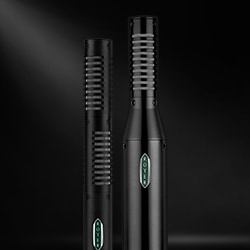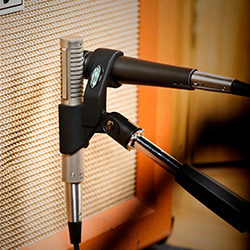Customer Kudos
"zZounds has single-handedly fueled my gear acquisition syndrome. I will be buying from you all until you shut the doors."
May 29, 2025
Royer Labs Microphones: zZounds Spotlight
Meet the mics that led the ribbon revolution
Famous for their "you are there" realism and high SPL handling, Royer ribbon microphones are studio staples for recording guitar amps, horns, and much more! Royer Labs led the ribbon-mic revolution of the late 1990s and 2000s, reintroducing studio engineers to ribbon microphones as versatile, real-world-usable tools.
Royer ribbons are first-call mics for recording guitar amps, and you'll also find they're a natural on just about any source, from drum overheads to vocals. These mics hear like your ears, with uncanny accuracy. If you like what you hear standing in front of your amp or coming out of your instrument, a Royer mic will capture it!
Explore all the Royer Labs gear zZounds has to offer in this Spotlight guide!
Shop all Royer Labs »
Royer ribbons are first-call mics for recording guitar amps, and you'll also find they're a natural on just about any source, from drum overheads to vocals. These mics hear like your ears, with uncanny accuracy. If you like what you hear standing in front of your amp or coming out of your instrument, a Royer mic will capture it!
Explore all the Royer Labs gear zZounds has to offer in this Spotlight guide!
Royer R-Series: Modern-classic ribbon mics for capturing guitar amps and much more
Royer Labs' flagship R-121, R-122 MKII, and R-10 microphones use the Royer R-series ribbon transducer. This is the transducer that revolutionized ribbon mics, earning Royer their reputation for "tough ribbons" that could easily stand up to high-SPL sources like a wide-open, screaming-loud guitar amp! In fact, the R-series transducer can handle 135 dB SPL at 20-30 Hz -- a massive low-end rumble -- and at 1 kHz, around the midrange meat of your sound, it'll handle upwards of 170 dB. Yet it's sensitive enough to capture acoustic instruments and vocals, too. With a slight rise in the upper midrange, this transducer gives R-series mics their characteristic presence that makes them such a great fit for recording rock, pop, jazz, and country.
If you look inside an R-series mic, you'll see an extremely thin (2.5 micron) strip of tightly corrugated aluminum -- the ribbon element itself. Framing the ribbon element, a pair of powerful neodymium magnets concentrates considerable magnetic energy on the gap between them. As sound pressure enters the mic, it hits the flexible, light-yet-strong ribbon, which moves through this magnetic field and generates an electrical signal we can record as sound.
Looking closely at the R-series ribbon, you'll also notice that it's slightly closer to the front of the microphone than the back -- Royer's patented offset ribbon design that keeps the ribbon within the strong magnetic field even when it's in front of a high-SPL source, and also makes the response on the back side of the microphone a little brighter than the front.
If you look inside an R-series mic, you'll see an extremely thin (2.5 micron) strip of tightly corrugated aluminum -- the ribbon element itself. Framing the ribbon element, a pair of powerful neodymium magnets concentrates considerable magnetic energy on the gap between them. As sound pressure enters the mic, it hits the flexible, light-yet-strong ribbon, which moves through this magnetic field and generates an electrical signal we can record as sound.
Looking closely at the R-series ribbon, you'll also notice that it's slightly closer to the front of the microphone than the back -- Royer's patented offset ribbon design that keeps the ribbon within the strong magnetic field even when it's in front of a high-SPL source, and also makes the response on the back side of the microphone a little brighter than the front.
Royer SF-Series: Ultra-accurate ribbon mics that shine on acoustic sources
Royer Labs' SF-series mics, like the SF-12 and SF-2, use the SF-series transducer. It's a more traditional design than the R-series transducer, with a shorter, narrower, and even thinner (1.8 micron) ribbon element. This extremely low-mass ribbon delivers superb, ultra-fast transient response that gives Royer's SF-series mics their what-you-hear-is-what-you-get accuracy. The ribbon element is framed by four powerful neodymium magnets in a cross-field design that delivers maximum high-frequency response for "condenser-like" clarity. The result is a mic with a wide, flat response that reaches further into the high-frequency range than Royer's R-series mics, and can also capture lows down to 30 Hz.
While SF-series mics can handle a respectable 130 dB SPL (at 40 Hz), they are not recommended for extremely loud applications. Their pure, uncolored sound makes them an excellent fit for acoustic instruments like woodwinds and strings. Royer's SF-series stereo ribbon microphones, like the Royer SF-12, are ideal for capturing orchestras, choirs, acoustic ensembles, drum overheads, and more with uncanny stereo imaging. If you don't think one microphone can capture an orchestra in its entirety, you might be surprised by what a Royer SF-12 stereo ribbon mic can do!
While SF-series mics can handle a respectable 130 dB SPL (at 40 Hz), they are not recommended for extremely loud applications. Their pure, uncolored sound makes them an excellent fit for acoustic instruments like woodwinds and strings. Royer's SF-series stereo ribbon microphones, like the Royer SF-12, are ideal for capturing orchestras, choirs, acoustic ensembles, drum overheads, and more with uncanny stereo imaging. If you don't think one microphone can capture an orchestra in its entirety, you might be surprised by what a Royer SF-12 stereo ribbon mic can do!
Royer dBoosters: In-line gain boosters for ribbon and dynamic mics
The Royer dBooster in-line microphone booster lets you add +12 dB or +20 dB of clean gain to a low-level microphone signal, resulting in a louder signal that can easily "drive" the preamps built into your digital audio interface. These in-line preamps are an easy way to bring your mics to life, giving you a fuller, clearer, more open-sounding signal that's robust enough to hold up to processing.
Since all passive ribbon microphones and dynamic microphones produce low-level signals -- especially when recording sources that can be very soft, like voices or acoustic instruments -- they need to be plugged into a preamplifier with enough clean gain to amplify that signal to a healthy level without adding noise or otherwise degrading the sound. However, the mic preamps built into many modern audio interfaces just can't supply the 60-70+ dB of clean gain that these microphones require. When you crank up the gain knob to maximum on your preamp, you may notice an audible noise floor that'll become more and more apparent as you layer multiple tracks and add processing like compression and limiting. That's why an in-line mic preamp like a Royer dBooster can save your signal by capturing cleaner audio at the source!
Since all passive ribbon microphones and dynamic microphones produce low-level signals -- especially when recording sources that can be very soft, like voices or acoustic instruments -- they need to be plugged into a preamplifier with enough clean gain to amplify that signal to a healthy level without adding noise or otherwise degrading the sound. However, the mic preamps built into many modern audio interfaces just can't supply the 60-70+ dB of clean gain that these microphones require. When you crank up the gain knob to maximum on your preamp, you may notice an audible noise floor that'll become more and more apparent as you layer multiple tracks and add processing like compression and limiting. That's why an in-line mic preamp like a Royer dBooster can save your signal by capturing cleaner audio at the source!
Royer Microphone Mounts and Accessories
A great mic deserves a great mic mount! Check out Royer's ingenious AxeMount, a clip that holds two mics -- the Royer R-121 plus a Shure SM57-style dynamic -- in the perfect phase-aligned position on a guitar amp cab. This smart accessory makes mic'ing up your amplifier quick and easy.
Unlike traditional shockmounts that use elastic bands that can disintegrate or stretch, Royer's patented Sling-Shock shockmounts are made to be durable and deliver exceptional isolation, while holding your mic securely.
Royer ribbon mics are a studio secret weapon for capturing smooth, natural-sounding vocals, and like any vocal mic, they benefit from a quality pop shield. Try Royer's metal pop shields for deflecting plosive P-pops without filtering out high frequencies.
Unlike traditional shockmounts that use elastic bands that can disintegrate or stretch, Royer's patented Sling-Shock shockmounts are made to be durable and deliver exceptional isolation, while holding your mic securely.
Royer ribbon mics are a studio secret weapon for capturing smooth, natural-sounding vocals, and like any vocal mic, they benefit from a quality pop shield. Try Royer's metal pop shields for deflecting plosive P-pops without filtering out high frequencies.




